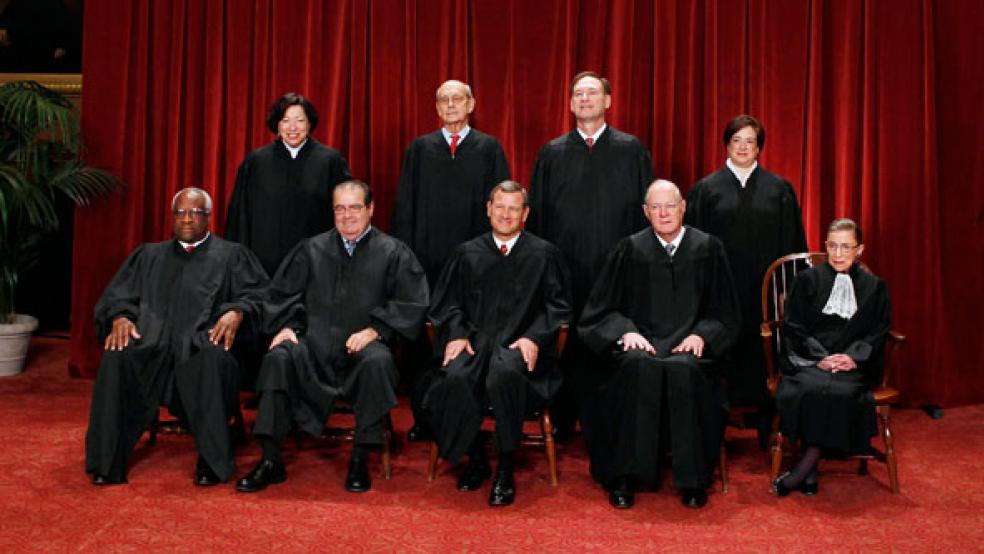The U.S. Supreme Court on Monday ruled the Obama administration should have considered compliance cost when it decided to limit emissions of mercury and other hazardous air pollutants mainly from coal-fired power plants, a setback for the government that leaves the legal status of the regulation in limbo.
The court ruled in a 5-4 decision, with its five conservative justices in the majority, against the U.S. Environmental Protection Agency (EPA). The rule stays in effect for the time being, with the case returning to an appeals court, which will decide whether or not it should be thrown out.
"EPA is disappointed that the court did not uphold the rule, but this rule was issued more than three years ago, investments have been made and most plants are already well on their way to compliance," the agency said in a statement.
The EPA "remains committed to ensuring that appropriate standards are in place to protect the public from the significant amount of toxic emissions from coal and oil-fired electric utilities and continue reducing the toxic pollution from these facilities," the agency added.
Related: Employee Misconduct Runs Rampant at the EPA
Justice Antonin Scalia, writing on behalf of the court, said that a provision of the Clean Air Act that said the EPA can regulate power plants for mercury and other toxic pollutants if it deems it "appropriate and necessary" must be interpreted as including a consideration of costs. The EPA had decided it did not have to consider costs at that stage of the process.
"The agency must consider cost - including, most importantly, cost of compliance - before deciding whether regulation is appropriate and necessary," Scalia wrote.
The EPA says the rule, which went into effect in April, applies to about 1,400 electricity-generating units at 600 power plants. Many are already in compliance, the U.S. Energy Information Administration said.
The legal rationale adopted by the court is unlikely to have broader implications for other environmental regulations, including the Obama administration's Clean Power Plan that would cut carbon emissions from existing power plants, according to lawyers following the case.
Related: The EPA Takes Aim at the Trucking Industry
William Yeatman, a fellow at the conservative-leaning Competitive Enterprise Institute, said the impact is "circumscribed" due to the "narrowness and uniqueness" of the legal provision the court was examining.
Richard Revesz, director of the Institute of Policy Integrity at New York University School of Law, said that "nothing in this decision would in any way call into question the legal legitimacy of the Clean Power Plan."
BIGGER BILLS
Industry groups and 21 states appealed after an appeals court upheld the regulation in June 2014. The challengers said the EPA's refusal to consider the estimated $9.6 billion-a-year costs would lead to bigger electricity bills for Americans.
Related: Obama’s Budget Boosts EPA to Fight Climate Change
Among companies opposing the rule was Peabody Energy Corp, the nation's largest coal producer. Exelon Corp, the biggest U.S. nuclear power plant operator, was one of several power companies supporting the rule.
The ruling gave an immediate lift to shares of Peabody and other coal mining companies, which have been dogged by concerns over the costs of the regulation and slumping coal prices as power companies turn increasingly to natural gas to generate electricity. Peabody shares were up 9 percent and rival Arch Coal shot up 13 percent. The Dow Jones Coal Index was up 1.36 percent after touching a 12-year low just before the ruling was issued.
The 2012 mercury regulation, which covered oil-fired plants as well as coal-burning ones, was targeted by Michigan and other states in addition to various industry groups, including the National Mining Association.
When the EPA issued the regulation, it outlined what it saw as the rule's costs and benefits, including preventing up to 11,000 premature deaths annually. The agency also said the regulation could generate billions of dollars in benefits including a reduction in mercury poisoning, which can lead to developmental delays and abnormalities in children. Overall, the EPA said the benefits could be worth up to $90 billion a year.
Related: Obama Just Scored a Double Victory on Climate Change
Vickie Paton, general counsel of the Environmental Defense Fund, which backed the Obama administration, said the EPA should be able to address the concerns raised by the court because it has "already analyzed the economics showing that the health benefits for our nation far outweigh the costs."
The case was the third recent Supreme Court test of President Barack Obama's air pollution regulations. The administration mostly came out on top in the two previous cases.
In April 2014, the court upheld a regulation limiting air pollution across state lines. In June 2014, the court largely upheld the government's ability to regulate greenhouse gas emissions from major utilities.
Industry groups and states are gearing up to challenge EPA's plans to issue new regulations aimed at curbing carbon emissions from existing power plants.
The three consolidated cases are Michigan v. EPA, 14-46, Utility Air Regulatory Group v. EPA, 14-47, National Mining Association v. EPA, 14-49.




